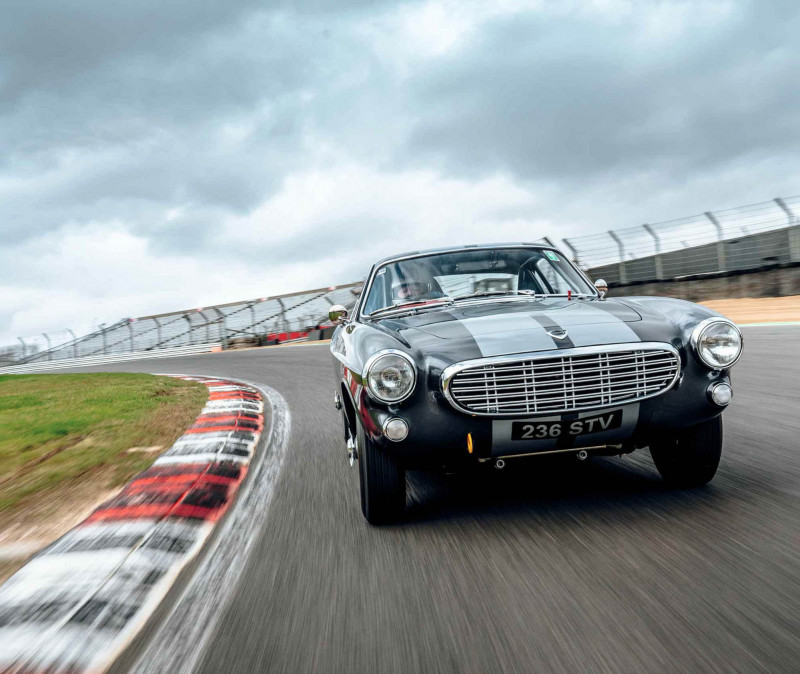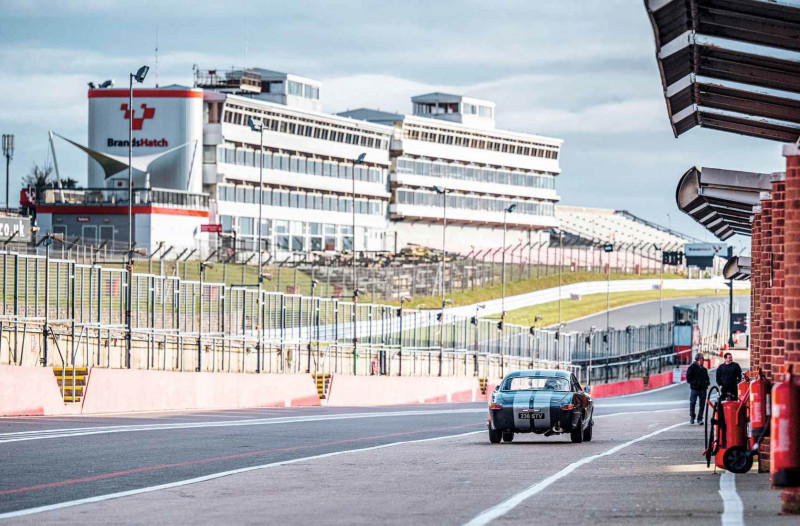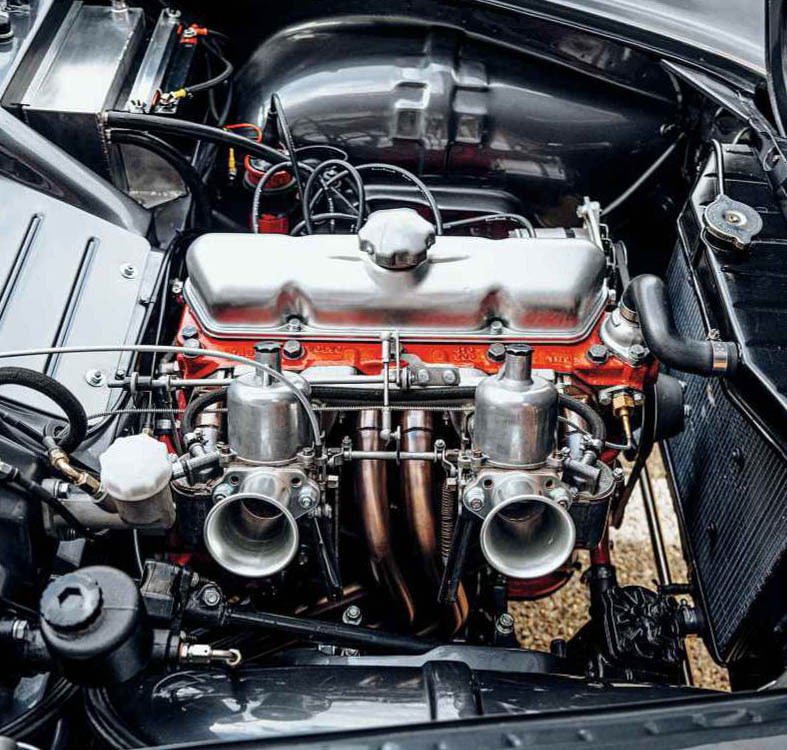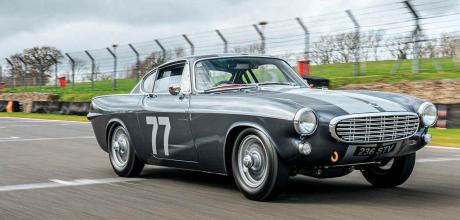1963 Volvo P1800 Racer
There aren’t so many Volvo P1800s in Historic racing, though maybe there should be — as both history and this brilliant build would suggest.
Words John Simister
Photography Jayson Fong
Just like those surprising Le Mans entrants
SAINT OF THE CIRCUIT
Revenge was sweet for Enzo Ferrari in February 1967 s Daytona 24 Hours, that year’s first World Sportscar Championship endurance race.

‘THE VOLVO HAD A STRONG PRESENCE IN CLUB-LEVEL RACING, BUT ITS SHOWING IN THE GREAT ENDURANCE RACES HAS SLIPPED UNDER THE RADAR’

Having been humiliated the previous June at Le Mans as three 7.0-litre Ford GT40 Mklls finished almost abreast in the top three places, the Ferrari team reprised that stunt at Daytona with two brand new 330 P4s and a P3 mostly modified to the new specification. The sole Ford Mkll to finish managed a lowly seventh, between two smaller-engined GT40s.

Two more Fords were in the top 12: a Mustang and a Falcon. Porsches — a 910, a 906 and two 911s — filled the rest of the dozen. And what was in 13th place? A Volvo P1800.
Fuel economy — so fewer pit stops — and reliability were key to the success of Volvo drivers John Tremblay and Larry Perkins, the latter not the Australian of the same name who briefly flirted with Formula 1. Yet theirs seemed a surprising choice of machine. Or was it?

In Europe (especially its native Sweden) and in the US, the Volvo had quite a strong presence in 1960s club-level racing, but it’s the model’s showing in the great endurance races that has slipped under the radar. True, placings in the 20s and the 30s hardly merited mentions in the international motorsport press, but right from the P1800’s first full year in competition (1962) the cars finished and beat much more glamorous machinery that did not. A photograph from 1962’s Nurburgring 1000km (above) shows two Volvos already well ahead of a Ferrari, an E-type and a Cobra after the Le Mans-style start, for the simple reason that it was easier to get going in a P1800 than in those racier but more cramped machines.
All of which leads to the handsome, wire-wheeled, grey P1800 you see here. It’s not an actual period racer — finding such a survivor is highly unlikely — but rather a recreation in period specification to FIA rules, built to race today. It belongs to John Pearson, late of Virgin Radio, nowadays prime mover behind Equipe Classic Racing, which runs races for period machinery. These include events for pre-1963 sports and GT cars, and ‘GTS’ races for pre- 1966 examples with relatively small engines. John’s Volvo would sit well in either category.
Having enjoyed racing several more obvious classic sports cars, John has been seeking something a bit unusual. To this end he has not only just acquired a bright red 1963 Corvette Sting Ray in semi-race-prepared condition, but he has also been project-managing this 1963-registered Volvo from scratch.
Why a Volvo? Impulse, mostly. ‘My wife Suzanne and I were at the Circuit des Remparts weekend in Angouleme,’ John relates, ‘and we spotted a fantastic P1800 outside our hotel, in dark grey with red leather. We loved it. I looked into the models racing history and got fired up, and the project started right there.’
But how? Its not as if there’s a ready-made pool of racing Pl800 expertise, nor of the cars themselves. John says that any P1800s racing today, be they in the US or in Scandinavia, tend to be hot rods with big engines and wheels to match. They are definitely not to FIA spec. What was needed, then, was a car purpose-built from scratch. Enter Buckinghamshire-based P1800 restoration maestros Templar and Wilde.
Those aren’t their actual names, of course; they are more the fantasy result of a protagonist in a certain 1960s thriller series, and another protagonist in a second series co-starring the main actor from the first, deciding to abandon the derring-do and take up car restoration. Anyway, the company’s Keith Forrest found a suitable donor P1800 and set about managing the sort of restoration in which you’ll find no evidence that anything has ever been repaired.
It’s as if the bodyshell has just been completed at the Pressed Steel plant at Linwood, opposite what became the Hillman Imp factory, before being sent down to West Bromwich where Jensen Motors assembled it with Amazon- derived mechanicals. That’s how the early P1800s were made before Volvo took the task in-house and renamed its shapely coupe 1800S.
Clearly the building of 236 STV — which is road-legal and registered, by the way — hasn’t quite followed Templar and Wilde Classics’ usual progression. There was a roll cage to design, fit and paint in body colour, for example, and John Pearson got electrics expert Pete Samuels to wire it with aircraft-quality cabling and connectors. Each cable has its destination printed on its sleeving, and circuitbreakers are used instead of fuses.
The interior retains plenty of the Volvo vibe, but the side windows are Perspex and the doortrims are redesigned without window winders, there no longer being winding mechanisms inside. The dashboard contains new race-relevant instruments, set within bezels machined from billet aluminium to fit the original facia and mimic the look of the original dials. The heater has gone, saving 7kg, replaced by heating elements in the windscreen.
Much of the build into Templar and Wilde’s beautiful bodyshell was done by technician Nick Crewdson. He installed the Volvo B18 engine, correct for the P1800 but enhanced with tuning parts developed for rallying Amazons and built by Vulcan Engineering. John’s hands were tied here by the specification of racing P1800s in period, whose engines were never developed to their full potential.
Marcos used the B18 in its own 1800, the first Marcos properly developed for road use and wide appeal, and equipped some cars with power-enhancing Weber DCOEs. But, says John, these are denied to the Volvo. ‘For FIA papers we have to use the original SU HS6s. Vulcan did a lot of work to get the best from them, but early on we were struggling to get the power. Replacing our brand new carbs with a pair I had left over from an MGB helped a lot, but in the end we had to get a one-off exhaust manifold made and have the FIA-required standard distributor built to match the advance curve we’d mapped out on an electronic unit.’
Certainly the engine looks fabulous with its open intake trumpets and its work of exhaust manifold art, both primary and secondary pipes long in the pursuit of torque. Power? It hasn’t been on the dynamometer yet, but around 145bhp — a useful boost over the original 103bhp — seems plausible.
Now, with the engine performing as it should, the Volvo is in the Brands Hatch pits ready for its first-ever track test. John has squirted it up the road to make sure it all works, but it seems that I, with the Volvo my mount for the trackday’s mandatory sighting lap around the short ‘Indy’ circuit, am to be the first to take it on a track. John’s trust is touching.
To watch over me, and depicted on each front wing, is a saint. The Saint, no less, the stick man of TV fame; you knew the reference would appear at some point. (That other TV series, with the Danny Wilde character, is The Persuaders!, by the way.) And for his new role, the Saint has been given a crash helmet by graphic designer Suzanne.
P1800-fanciers might spot the front grille from a later version in place of the egg-crate’ original: later is lighter. At the back, the racerequired red rain light is in the housing for the numberplate light, where it has ousted the original reversing light. Then there are those painted wire wheels, an option in period but actually heavier than the standard steels. ‘They do look good, though,’ says John. They wear Dunlop L-type racing crossplies.
Inside, there’s no carpet, no soundproofing. Just a single racing seat, incongruous against the red leather doortrims and side panels and most easily entered if the quick-release steering wheel is removed beforehand and replaced once I’m belted in. A red protective toggle is flicked up to reveal the ignition button, which I press. Now I prod the adjacent starter button: the B18 motor chunters into life with open-intake rortiness but an exhaust note restrained by racecar standards. It’s a trackday today, after all.
Firm but smooth clutch, handbrake inoperable with the door shut (it’s low down to the right of the seat, so stays off), and off we go on the sighting lap. The toothy whine from the gearbox is not just the result of missing sound insulation; inside is a straight-cut, dose-ratio gearset made by Quaife and found at restorer, race-preparer and Goodwood stalwart CCK in Sussex, which built it into the standard Volvo casing.
Those racing Dunlops feel a touch wooden when cold but will soon become super-progressive in their grip curve as they warm, drifting sooner than radials — an unsettling feeling at first — and, I’m told, ultimately letting go gently compared with a radial’s more sudden capitulation. That’s how expert racing drivers can hold those lovely four-wheel drifts for so long, and make it look so easy.
Sighting lap over, I’m soon back out on the track and free to go as fast as I dare. The off-camber, downhill, half-blind Paddock Hill Bend that is the lap’s first challenge quickly reminds me of discretion’s benefits, so I’ll build up speed gradually in this untried, unique Volvo. The rev-counter isn’t currently working so I’m driving a bit blind, but there’s plenty of torque and it’s all reaching the track surface as I accelerate out of each corner. The limited-slip differential — ‘an ultra-rare period item supplied by Rob at Amazon Cars,’ John reveals — is clearly helping here.
So is the fact that the suspension settings, calculated by Rob Quinn at Quintec, seem to be pretty much bang-on. ‘The damper bodies are Protech but we valved them, after working out what the damping needed to be,’ Rob explains. He makes it sound simple, but there’s weight and its distribution to consider, the stiffness of springs and anti-roll bars to calculate, geometry to set. ‘He’s a handling genius,’ says John.
Now I’m daring to go a touch faster on this very three-dimensional track, where even the straight isn’t quite straight, and a few imperfections are surfacing in this perfectlooking machine. The brakes feel soft, but are powerful enough. The gearchange is a bit stiff, but at least I haven’t lost my way in the gate. And is it those progressive tyres, or does the nose feel less than intimately connected with the tarmacadam? It’s not understeering to excess, just enough to feel stable and benign, but the communication is foggy, which doesn’t help a driver’s confidence.
Now John has a go in his new toy, and on his return he too thinks things could be sharper.
So into the driving seat is threaded Karl Jones, ex-racer of BTCC Sierra Cosworths, ace driver coach and top assessor of a car’s racing dynamics. He immediately takes the Volvo to, shall we say, the edge of the dynamic envelope, returns to our pit and declares a need for more steering castor. Nick Crewdson and Rob Quinn set about the front subframe, a tweak is made and Karl goes out again. ‘Much better,’ he says on his return. ‘You can lean on it now and feel what it’s doing.’
My turn again and yes, it’s a whole lot easier to commit to a corner and a whole lot more fun. The Volvo has turned talkative and liberties can now be taken. On my previous laps I had just thought the Volvo was simply doing what a P1800 does, and drove accordingly. Such are the benefits of a test day, with the chance to discover what is possible when the right knowledge is at hand.
Could John Pearson’s P1800 be a race winner, or even a class winner? He doesn’t think so: ‘It’s quite heavy, around 1000kg ready to race, so I don’t think we’ll be troubling the podium.’
That, though, isn’t really the point. ‘The fun with the Volvo has been in developing it,’ John continues. ‘Unlike with an MGB, for example, there’s no big knowledge base, no-one to ask. We’ve had to discover it all for ourselves. And then there’s the warmth it generates. People just love to see it.’
As I write this, the Volvo is being readied for its first race tomorrow. After that, John would like to make full use of the giant 80-litre aluminium tank in the boot and do some endurance races as Pl800s used to do. Maybe one day someone else will build another one for him to race against. Until then, there will be no faster P1800 than 236 STV.
Above and right Only the one seat in this P1800; John Simister compares notes with owner John Pearson (in racesuit) at Druids hairpin.
Clockwise, from right ‘The Saint' graphic has been suitably race-modded; racing tank takes up much of the boot; tuned 1.8 should be good for 145bhp; geometry tweaks have transformed the P1800's handling.
Clockwise, from above In the pitlane at Brands Hatch, ready for that first lap; serious roll-cage contrasts with exquisite leather trim; in the hot seat, surveying a full set of racing clocks.
TECHNICAL DATA 1963 Volvo P1800 Racer
- Engine 1782cc four-cylinder, OHV, two SU HS6 carburettors
- Max Power c145bhp
- Max Torque Not yet measured
- Transmission Four-speed manual, rear-wheel drive
- Suspension Front: double wishbones, coil springs, telescopic dampers, anti-roll bar. Rear: live axle, upper and lower radius arms, Panhard rod, coil springs, Protech telescopic dampers
- Steering Worm and roller
- Brakes Discs front, drums rear
- Weight c1000kg
- Top speed 125mph (est)
- 0-60mph 8.5sec (est)
Right and below On the opening lap of the 1962 Nurburgring 1000km, two Volvo P1800s get ahead of the more usual suspects; John Pearson's P1800 in good company with its Corvette stablemate


